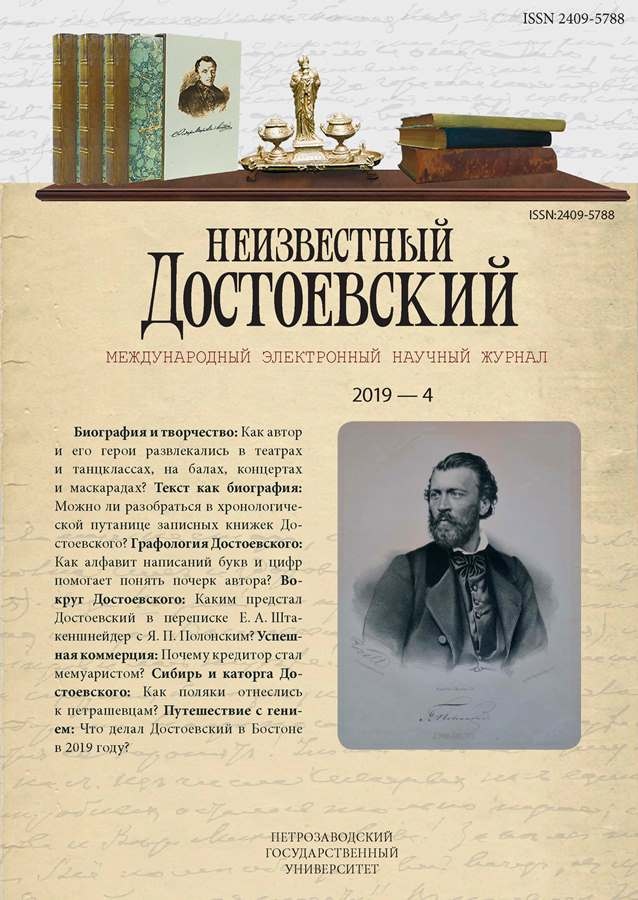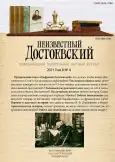Том 8, № 4 (2021)
Статьи
Памяти Деборы Мартинсен
 5-6
5-6


Перспективы, возможности и трудности созданiя цифрового Достоевскаго въ традицiонной русской орѳографiи
Аннотация
Въ статьѣ разсмотрѣнъ вопросъ о необходимости переизданiя въ авторской орѳографiи текстовъ классической отечественной литературы въ цѣломъ, а также творческаго наслѣдiя Ѳ. М. Достоевскаго въ частности. Проанализированы ключевыя культурныя и технологическiя препятствiя на пути къ обращенiю общественнаго и научнаго вниманiя на проблему недостаточнаго количества книгъ, выпускаемыхъ въ традицiонной орѳографiи на сегодняшнiй день. Предложенъ наборъ практикъ и рѣшенiй, способствующихъ измѣненiю актуальнаго положенiя въ долгосрочной и краткосрочной перспективахъ. Съ опорой на историческiй опытъ, а также работы современныхъ изслѣдователей въ области текстологiи освѣщено соцiокультурное функцiонированiе традицiоннаго правописанiя въ Россiи въ настоящее время. Это языкъ, на которомъ создана русская классика. Реабилитацiя и функцiонированiе традицiоннаго правописанiя предполагаетъ возможность писать и публиковать свои тексты въ научномъ и дѣловомъ общенiи. Не-обходимо поощрять использованiе традицiонной орѳографiи въ профессiональной литературно-критической и лингвистической дѣятельности. Требуютъ своего рѣшенiя техническiе вопросы — въ частности, введенiе новаго стандарта раскладки русской клавiатуры, развитiе информацiонныхъ и справочныхъ сервисовъ по исторiи русскаго языка, инструментовъ и технологiй созданiя электронныхъ текстовъ. Созданiе цифрового Достоевскаго можетъ помочь рѣшить задачи варiативнаго использованiя традицiонной письменности русскаго языка.
 7-20
7-20


«Отвечать»: записи и пометы Достоевского на письмах и конвертах его корреспондентов
Аннотация
Ф. М. Достоевский получал огромную корреспонденцию, особенно в 1970-е гг. — время издания «Дневника Писателя». Сохранилось свыше 1 600 писем к нему от более чем 500 адресантов. Этот объем сопоставим только с корреспонденцией Л. Толстого в 1880–1890-е гг., на которую ему помогали отвечать многочисленные помощники. Достоевский не имел возможности отвечать на все письма, но старался не оставлять без внимания корреспонденцию читателей. О его работе с полученными письмами свидетельствуют сделанные на них записи и пометы (в том числе невербальные). Они систематизированы в издании «Рукописное наследие Ф. М. Достоевского» (2021) и проанализированы в данной статье. Выявлено 109 записей и помет Достоевского на письмах его адресантов 1859–1881 гг., из них три впервые — на конвертах писем О. А. Антиповой от 7 мая 1877 г., кн. Н. Н. Голицына от 9 февраля 1878 г., на листе письма Д. А. Инсарского от 14 августа 1864 г. Систематизация записей и помет писателя на письмах корреспондентов позволила выделить из них три группы. Это записи, в которых содержится информация об адресантах и их письмах и которые сделаны автором «Дневника Писателя» непосредственно после прочтения писем; черновые наброски произведений; записи для памяти (адреса, списки носильных вещей, денежные подсчеты, связанные с изданием сочинений). В процессе работы над описанием помет Достоевского был уточнен текст некоторых записей, исправлены ошибки, допущенные в академическом Полном собрании сочинений писателя (инициалы адресантов, датировки писем и др.). Записи и пометы Достоевского на письмах его корреспондентов отражают творческий процесс писателя, подробности быта и издательской деятельности, живой диалог автора с читателями.
 21-37
21-37


Дополнения к комментарию (на материале записных книжек и тетрадей Ф. М. Достоевского 1860-х гг.)
Аннотация
В статье анализируются некоторые имена собственные и названия из записных книжек и тетрадей Ф. М. Достоевского 1860-х гг. (ОР РГБ. Ф. 93.I.2.8 и РГАЛИ. Ф. 212.1.4, 212.1.5). Некоторые из них не были расшифрованы или имеют спорное прочтение в исследовательской литературе. Это не только имена людей, с которыми Достоевский общался лично, но и имена авторов книг, которые читал писатель, а также антропонимы литературных произведений. Отталкиваясь от комментариев, сопровождающих первые публикации записных книжек и тетрадей в 83 т. серии «Литературное наследство», а также в 20 и 27 тт. Полного собрания сочинений писателя в 30 томах, автор статьи предлагает дополненный и/или исправленный комментарий к некоторым именам и названиям. Так, устанавливается правильное название книги историка И. Д. Беляева, которая имелась в библиотеке писателя и о которой сделана запись для памяти. В записных книжках и тетрадях Достоевский часто оставлял свои критические заметки касательно произведений того или иного современника. В статье рассматривается ряд записей о «нигилистических романах», вызванных прочтением современных писателю произведений о женской эмансипации. Оспаривается комментарий Т. И. Орнатской, относящей имя «Лилинька» и записи, связанные с ним, к рассказу А. В. Корвин-Круковской «Сон», что подтверждает мнение других исследователей о том, что источник записей — роман Н. Д. Ахшарумова «Мудреное дело». В статье проанализированы также пометы, касающиеся долгов писателя (например, В. П. Полякову, П. А. Попову или В. П. Попову) и несостоявшихся и неизвестных авторов «Эпохи» (некто Андреев). В записных книжках и тетрадях Достоевского периода «Времени» и «Эпохи» (1860–1865 гг.) остаются еще имена собственные, которые до сегодняшнего времени не имеют соответствующих комментариев. Статья призвана обратить внимание исследователей на существующие проблемы для дальнейшей разработки темы.
 38-51
38-51


Из редакционного архива братьев Ф. М. и М. М. Достоевских (журналы «Время» и «Эпоха»)
Аннотация
Журналы «Время» и «Эпоха» привлекали внимание исследователей прежде всего в связи с личностью и творчеством писателя Федора Достоевского, принимавшего деятельное участие в изданиях брата, Михаила Достоевского. Это обстоятельство определило характер изучения журналов: как самостоятельные органы периодической печати 1860х гг. они менее исследованы, большинство работ посвящены отдельным аспектам. Несмотря на усилившееся в последние десятилетия внимание ко «Времени» и «Эпохе» со стороны исследователей, многие вопросы остались нерешенными: недо статочно изучена редакционная и гонорарная политика журналов, финансовая сторона издания, не решена в полной мере ключевая проблема атрибуции анонимных и псевдонимных журнальных статей — соавторство и редакторская работа Ф. М. Достоевского, определение степени участия писателя в текстах других авторов. В статье не только обозначены проблемы изучения «Времени» и «Эпохи» и роли Достоевского в журналах, но и представлен анализ некоторых материалов редакционного архива. Записи приходо-расходной книги открывают финансовую сторону издания (денежные затраты и доходы редакции), позволяют судить о ведении редакционно-издательских дел братьями Достоевскими, об успешности их предприятия. Гонорарная книга включает расписки со трудников в получении гонораров за работу. Соотношение расходов на оплату гонораров и полученных сумм сотрудниками журналов по гонорарной ведомости выявляет закономерность расчетов редакции с авторами. Материалы редакционного архива «Времени» и «Эпохи», проанализированные в данной статье, содержат ценные сведения для атрибуции анонимных и псевдонимных журнальных текстов. Данные редакционных книг, переписка сотрудников журналов мемуарные свидетельства и другие документальные источники позволяют подтвердить существующие атрибуции или обнаружить в них противоречия и выделить наиболее достоверные. Материалы редакционного архива «Времени», «Эпохи» значительно расширяют представления о двух периодических из даниях второй половины 1860х гг. и о деятельности писателя в них как части его творчества. Эти документы открывают широкие перспективы дальнейшего изучения и поиска ответов на вопросы.
 52-90
52-90


М. И. Семевский и Ф. М. Достоевский
Аннотация
В статье представлена история деловых и дружеских взаимоотношений Ф. М. Достоевского и М. И. Семевского, сотрудника журнала «Время» и редактора крупнейшего исторического журнала XIX столетия «Русская Старина». Семевский познакомился с Достоевским, по всей вероятности, в начале 1860-х гг., став автором журнала «Время» и написав для издания два масштабных исторических очерка «Царица Прасковья» и «Семейство Монсов». Достоевский был знаком с трудами Семевского еще до личных встреч и собирался полемизировать с его концепцией Петровского времени, о чем свидетельствуют сохранившиеся наброски критического отзыва писателя. Мысль о полемике была отклонена, когда Семевский стал автором журнала «Время». Редакторы, братья Достоевские, ценили его сотрудничество и, как подтверждается в гонорарной книге, платили выше, чем многим авторам. Встречи Достоевского и Семевского получили отражение в эпистолярном наследии и в заметках Семевского, которые он написал осенью 1866 г. после суда над революционером Николаем Ишутиным. В ноябре 1876 г. Семевский передал Достоевскому документы для «Дневника Писателя» с просьбой не указывать источник. На общение Достоевского и Семевского в последний год жизни писателя указывают воспоминания Е. Н. Опочинина. В статье дан обзор писем Достоевского 1854–1879 гг., размещенных в «Русской Старине» в 1883‒1885 гг., а также воспоминаний разных лиц о Достоевском, опубликованных при жизни редактора и после его смерти. В исследовании использованы архивные документы, раскрывающие новые факты биографии Достоевского, Семевского и их современников.
 91-111
91-111


Письма А. Г. и Л. Ф. Достоевских в архиве Национальной библиотеки Франции
Аннотация
В статье вводятся в научный оборот два письма, написанных вдовой и дочерью Ф. М. Достоевского в 1912 и 1924 гг. и адресованных известному французскому режиссеру Жаку Копо. Эти документы были обнаружены в результате архивных поисков в фонде Ж. Копо в Национальной библиотеке Франции. Оба письма связаны одной темой — дебютной постановкой Копо в парижском «Театре искусств» в 1911 г. пьесы «Братья Карамазовы». В рецензиях на постановку, опубликованных в европейской и российской прессе, присутствуют самые разные ее характеристики: от восторженных до резко отрицательных. В своем письме А. Г. Достоевская дала высокую оценку драме Копо — однако с ней она познакомилась, не видев самой театральной постановки, но прочитав книгу, которую режиссер выслал ей. Издание пьесы Копо по роману «Братья Карамазовы» — малоизвестный экспонат «Музея памяти Ф. М. Достоевского», организованного вдовой писателя в 1889 г. О нем упоминается только в записной книге А. Г. Достоевской 1912–1913 гг. На основе письма и записной книги вдовы писателя установлен год включения издания пьесы Копо в собрание «Музея памяти Ф. М. Достоевского». Письмо Л. Ф. Достоевской содержит сведения о ее общении с такими известными французскими литераторами, как Жак Копо, Ирэнэ Може и Поль Бурже, о попытках наследницы авторских прав получить гонорар за предпринятую Копо постановку. Эта информация дополняет имеющиеся на данный момент весьма скудные сведения об эмигрантском периоде биографии дочери писателя. В Приложении к статье опубликованы письма А. Г. и Л. Ф. Достоевских на французском языке и в переводе.
 112-129
112-129


Фатима Риза-Заде (Сайях), исследовательница Достоевского
Аннотация
Статья посвящена изучению биографии и достоевсковедческих работ Ф. РизаЗаде, известной также под именем Ф. Сайях. В научный оборот введен ряд архивных материалов, отражающих профессиональные и дружеские связи Ф. Риза-Заде 1929–1930-х гг., дан проблемный обзор статей «Достоевский и современная французская литература (о влиянии Достоевского)» и «Достоевский в западной критике», а также вышедшей в Тегеране статьи-предисловия к персидскому переводу романа Достоевского «Белые ночи». Отмечено, что работы исследовательницы заложили основы иранской компаративистики: творчество Достоевского было осмыслено в широком контексте французской литературы, немецкой философско-эстетической традиции, иранских культурных символов добра и зла. В своих методологических установках Ф. Риза-Заде ориентировалась на социологическую критику школы Переверзева, культурно-эстетический подход к анализу жанровой проблематики, самодостаточность литературоведческого исследования и отказ от философских спекуляций. Труды Ф. Риза-Заде сохранили свое значение в изучении и популяризации творчества Достоевского и развитии российско-иранских культурных связей.
 130-146
130-146


Где в сельце Даровом находилась усадьба Достоевских?
Аннотация
Усадьба Даровое — место, где провел детские годы (1832–1836) Ф. М. Достоевский. В статье анализируются результаты раскопок в центральной части усадьбы, осуществленных в 2005–2020 гг. Рассматривается датировка следов построек, комплексов (материковых ям), а также всей линзы культурного слоя в целом. На основании коллекции, включающей в себя монеты, клейма на стеклянных и фарфоровых изделиях, керамику, предметы из цветных металлов и железа, автор приходит к выводу, что на усадьбе в ее современных границах существовало два основных периода освоения. Первый относится к сер. XVIII — началу XIX вв., второй охватывает вторую пол. XIX — первую пол. ХХ вв. Анализ керамической коллекции позволил выделить типы керамики, характерные именно для 1820–1830-х гг. Автор делает вывод, что временной промежуток от наполеоновских войн до 1850-х гг. в имеющейся коллекции не представлен, и предполагает, что центр усадьбы в «период Достоевских» располагался за пределами современных границ музея.
 147-176
147-176


Работы К. А. Баршта о Достоевском: имитация научного исследования
Аннотация
В настоящей статье подвергнуты критическому анализу публикации К. А. Баршта, посвященные творчеству Ф. М. Достоевского: 1) работы о рисунках и каллиграфии писателя; 2) комментированное издание романа Ф. М. Достоевского «Бедные люди», подготовленное для серии «Литературные памятники»; 3) публикации о рукописях романа «Бесы», в том числе издание рабочих тетрадей Ф. М. Достоевского с черновыми записями к этому роману (2021); 4) статьи К. А. Баршта, включенные им в сборник «Достоевский: этимология повествования» (2019). Обращение к указанным публикациям обнаруживает непрофессионализм К. А. Баршта как исследователя, а также нарушение им научной этики. Авторы статьи исходят из мысли о том, что подобного рода имитация науки недопустима, а работы, представляемые в профессиональном сообществе как исследовательские, должны проходить квалифицированную научную экспертизу и получать оценку специалистов.
 177-231
177-231












